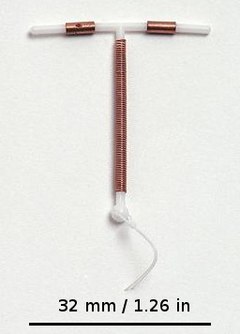宮內節育器
| 此條目論述以部分區域為主,未必有普世通用的觀點。 (2019年9月11日) |
| 此條目可参照英語維基百科相應條目来扩充。 (2019年1月22日) |
| 宮內節育器 | |
|---|---|
 | |
| 背景 | |
| 生育控制種類 | 子宮內 |
| 初次使用日期 | 1970年代[1] |
| 失效率比率 (頭一年) | |
| 完美使用 | <1% |
| 一般使用 | <1% |
| 用法 | |
| 注意事項 | ... |
| 優點及缺點 | |
| 是否可以防止性傳播疾病 | 否 |
| 週期 | ... |
| 是否影響體重 | ... |
| 好處 | ... |



宮內節育器(英語:Intra-uterine device,縮寫:IUD),或稱避孕器,是置於子宮內的避孕裝置,因早期設計為圓形,也稱為子宮環、節育環、避孕環。現今一般为T形,由醫生在月经期间放入子宮,在有效期限内可提供避孕效果[2]。宮內節育器屬於長效可逆避孕裝置[3]。在眾多避孕方式中,使用者對於宮內節育器和避孕植入管的滿意度最高[4]。有研究指出家庭計劃提供者中有41.7%選用長效可逆避孕裝置,較一般大眾的12.1%要高[5]。
宮內節育器對於青少女及先前未曾懷孕過的女性也是安全有效的[4][6][7];此外,即便已使用節育器很長一段時間,只要加以移除,女性的生育能力即會迅速回復正常[8]。使用含銅節育器的避孕失敗率大約為0.8%,而含有激素(左炔诺孕酮)的節育器在使用第1年期間的避孕失敗率則只有大約0.2%[9]。相較之下,男性結紮及性交時使用保險套的避孕失敗率則分別為0.15%及15%。另外當女性發生不安全性行為時,也可在5天內使用含銅節育器來緊急避孕[10]。
使用銅製節育器可能會增加月經的出血量,導致更嚴重的經痛[11];而改用塗抹激素的節育器則除了避育的效果外,還可同時減少或是完全停止月經[12]。不過在使用後的前幾個月女性反而可能會每日出血,大概要經過3個月才能減少90%的出血量[13]。至於經痛則可服用非類固醇消炎藥加以緩解[14]。更嚴重的潛在併發症包含節育器本身脫落(expulsion)(約2至5%)及罕見的子宮穿孔(少於0.7%)等[15]。宮內節育器不會影響哺乳,所以可在母親分娩後立刻置入[15];此外,當婦女墮胎後也可立刻置入[16]。
美國使用宮內節育器的比例由1995年的0.8%上昇到2006年至2010年的5.6%[17]。自1800年代起就已有宮內節育器的避孕方式[18]。以往有一種稱為達康盾的宮內節育器,因為會提高骨盆腔發炎(PID)的風險,已不再使用。目前使用的宮內節育器,若女性在置入時沒有性傳染疾病,宮內節育器不會提高骨盆腔發炎的風險[19]。
在合格的产品和专业人员放置的情况下,宮內節育器是一种相对安全有效的避孕方式。全世界有近1.8億名婦女使用。中国已婚育龄(50岁以下)妇女中宫内节育器使用人数达1.3億人[20]。
类型[编辑]
宮內節育器可分为含激素类和含铜类。激素可缓慢释放,使女性不孕,有效期可达5年;而铜会缓慢放出铜离子,防止怀孕,有效期可达12年。
激素型避孕器[编辑]
激素型避孕器会在子宫中缓慢释放激素以防止怀孕。有效期因产品而异。优点包括月经的量会减少,可以治疗经血过量,纠正月经不调。副作用和避孕药相似。
含銅避孕器[编辑]
含銅避孕器的主要作用原理是减弱精子活性,从而阻止受精。它在子宫内会缓慢释放出的铜离子有杀精子作用,而且会提高子宫内前列腺素和白细胞的浓度[21][22],使精子无法穿过宫颈粘液[23]。据统计,它第一年的失败率为0.2%-2.2%[24]。
非激素型避孕器一般塑料材质,外面缠绕着金属铜,形状多为T形,安装时T上面的部分位于子宫上部。现在有些避孕器中加入了金、银等贵金属以减少腐蚀。不同的类型的有不同的使用期限。
它的优点:可作为紧急事后避孕手段(性行為發生後五天內)[25]。不含激素,因此可以在哺乳期使用,取出后可迅速恢复生育能力。它的缺点:可能会造成经血过量和绞痛[21]。
缺点和不良反应[编辑]
和避孕套不同,宮內節育器不能防止性传播疾病,如艾滋病。有时宮內節育器会脱落,如果没有及时安装回去,则会导致避孕失效。
已知的不良反应有子宫穿孔、盆腔炎、痛经、月经不调、经血过多、一旦避孕失败则极有可能是宫外孕
通常情况下放置宫内节育器不需要止痛,但17%的未产妇和11%的经产妇疼痛严重,需要止痛[26]。
中華人民共和國使用情形[编辑]
中華人民共和國[编辑]
中華人民共和国2012年实施995万(另一统计为720万)例放置宫内节育器手术(俗称上环)和180万(另一统计为284万)例取出宫内节育器手术,造成480例子宫穿孔和1952例感染,已婚育龄(50岁以下)妇女中宫内节育器使用人数达1亿3185万人[20][27]。宫内节育器是中国的首要避孕措施,在所有避孕措施中使用率占54%,是避孕套的5倍多[28]。
中华人民共和国计划生育中的强制上环行为[编辑]
强制上环曾經是中华人民共和国计划生育中的節育措施之一。由于上環可有效防止怀孕,从而减少計生部門的工作量。1982年至1983年钱信忠任国家计划生育委员会主任期间提出“一胎上环,二胎绝育”,创造了1983年一年放置宫内节育器1776万例的记录[29]。虽然此后政策略有放松,但“一胎上环”的原则在许多地区延续至今,例如2014年修订的《广东省人口和计划生育条例》仍然规定“已生育一个子女的育龄夫妇,女方首选使用宫内节育器;已生育二个以上子女的,一方首选结扎措施”。
公安局辦證中心會以計生部門是否出具已上環證明為必要條件才可辦理小孩入戶口手續而強制婦女去上環,而不是婦女以自愿方式上環。而且有些上環衛生院的條件差,会造成子宫感染等并发症。
参考文献[编辑]
- ^ Goodwin, T. Murphy; Montoro, Martin N.; Muderspach, Laila; Paulson, Richard; Roy, Subir. Management of Common Problems in Obstetrics and Gynecology 5. John Wiley & Sons. 2010: 494–496 [2018-10-18]. ISBN 978-1-4443-9034-6. (原始内容存档于2019-05-20) (英语).
- ^ 存档副本. [2006-11-16]. (原始内容存档于2006-11-20).
- ^ Winner, Brooke; Peipert, Jeffrey F.; Zhao, Qiuhong; Buckel, Christina; Madden, Tessa; Allsworth, Jenifer E.; Secura, Gina M. Effectiveness of long-acting reversible contraception. The New England Journal of Medicine. 2012-05-24, 366 (21): 1998–2007 [2018-10-18]. ISSN 1533-4406. PMID 22621627. doi:10.1056/NEJMoa1110855. (原始内容存档于2018-10-18).
- ^ 4.0 4.1 Committee on Adolescent Health Care Long-Acting Reversible Contraception Working Group, The American College of Obstetricians and Gynecologists. Committee opinion no. 539: adolescents and long-acting reversible contraception: implants and intrauterine devices. Obstetrics and Gynecology. 2012-10, 120 (4): 983–988 [2018-10-18]. ISSN 1873-233X. PMID 22996129. doi:10.1097/AOG.0b013e3182723b7d. (原始内容存档于2018-10-18).
- ^ New Study Finds Women’s Health Providers Use IUDs More Than Any Other Method of Birth Control. (原始内容存档于2018-10-18).
- ^ Committee on Adolescent Health Care Long-Acting Reversible Contraception Working Group, The American College of Obstetricians and Gynecologists. Committee opinion no. 539: adolescents and long-acting reversible contraception: implants and intrauterine devices. Obstetrics and Gynecology. 2012-10, 120 (4): 983–988 [2018-10-18]. ISSN 1873-233X. PMID 22996129. doi:10.1097/AOG.0b013e3182723b7d. (原始内容存档于2018-10-18).
- ^ Black, Kirsten; Lotke, Pamela; Buhling, Kai J.; Zite, Nikki B. A review of barriers and myths preventing the more widespread use of intrauterine contraception in nulliparous women. The European Journal of Contraception & Reproductive Health Care. 2012-10-01, 17 (5): 340–348. ISSN 1362-5187. PMC 4950459
 . PMID 22834648. doi:10.3109/13625187.2012.700744.
. PMID 22834648. doi:10.3109/13625187.2012.700744.
- ^ Tommaso., Falcone,; W., Hurd, William. Clinical reproductive medicine and surgery. St. Louis, Mo.: Elsevier Mosby. 2007. ISBN 9780323076593. OCLC 489071020.
- ^ Joseph., Hurt, K.; Obstetrics., Johns Hopkins University. Department of Gynecology and. The Johns Hopkins manual of gynecology and obstetrics. 4th ed. Philadelphia: Wolters Kluwer Health/Lippincott Williams & Wilkins. 2011. ISBN 9781605474335. OCLC 648080236.
- ^ Emergency Contraception. (原始内容存档于2018-10-18).
- ^ McNicholas, Colleen; Peipert, Jeffrey F. Long-acting reversible contraception for adolescents. Current Opinion in Obstetrics & Gynecology. 2012-10, 24 (5): 293–298 [2018-10-18]. ISSN 1473-656X. PMC 4183267
 . PMID 22781078. doi:10.1097/GCO.0b013e32835686d5. (原始内容存档于2018-10-18).
. PMID 22781078. doi:10.1097/GCO.0b013e32835686d5. (原始内容存档于2018-10-18).
- ^ G., Gabbe, Steven. Obstetrics : normal and problem pregnancies 6th ed. Philadelphia: Elsevier/Saunders. 2012 [2018-10-18]. ISBN 9781455733958. OCLC 793126669. (原始内容存档于2020-05-27).
- ^ Donna,, Shoupe,. Contraception 1., Auflage. New York, NY: John Wiley & Sons. 2011. ISBN 9781444342635. OCLC 894717865.
- ^ Marnach, Mary L.; Long, Margaret E.; Casey, Petra M. Current issues in contraception. Mayo Clinic Proceedings. 2013-3, 88 (3): 295–299 [2018-10-18]. ISSN 1942-5546. PMID 23489454. doi:10.1016/j.mayocp.2013.01.007. (原始内容存档于2018-10-18).
- ^ 15.0 15.1 G., Gabbe, Steven. Obstetrics : normal and problem pregnancies 6th ed. Philadelphia: Elsevier/Saunders. 2012 [2018-10-18]. ISBN 9781455733958. OCLC 793126669. (原始内容存档于2020-05-27).
- ^ Steenland, Maria W.; Tepper, Naomi K.; Curtis, Kathryn M.; Kapp, Nathalie. Intrauterine contraceptive insertion postabortion: a systematic review. Contraception. 2011-11, 84 (5): 447–464 [2018-10-18]. ISSN 1879-0518. PMID 22018119. doi:10.1016/j.contraception.2011.03.007. (原始内容存档于2018-10-18).
- ^ Trends in Long-acting Reversible Contraception Use Among U.S. Women Aged 15–44. (原始内容存档于2018-10-18).
- ^ L.,, Callahan, Tamara. Blueprints obstetrics & gynecology 6th ed. Baltimore, MD: Lippincott Williams & Wilkins. 2013. ISBN 9781451117028. OCLC 800907400.
- ^ Sridhar, Aparna; Forbes, Elizabeth Ruppel; Mooney, Kelly; Rible, Radhika. Knowledge and Training of Intrauterine Devices Among Primary Care Residents: Implications for Graduate Medical Education. Journal of Graduate Medical Education. 2015-3, 7 (1): 9–11 [2018-10-18]. ISSN 1949-8349. PMC 4507936
 . PMID 26217412. doi:10.4300/JGME-D-14-00010.1. (原始内容存档于2018-10-18).
. PMID 26217412. doi:10.4300/JGME-D-14-00010.1. (原始内容存档于2018-10-18).
- ^ 20.0 20.1 《中国人口和就业统计年鉴》2013卷,表6-3和6-7。
- ^ 21.0 21.1 Grimes, DA, MD, Intrauterine Devices (IUDs), Hatcher, RA; Nelson, TJ; Guest, F; Kowal, D. (编), Contraceptive Technology 19th, New York: Ardent Media, 2007
- ^ Mechanisms of the Contraceptive Action of Hormonal Methods and Intrauterine Devices (IUDs). Family Health International. 2006 [2006-07-05]. (原始内容存档于2006-06-17).
- ^ Oritz ME, Croxatto HB. Copper-T intrauterine device and levonorgestrel intrauterine system: biological bases of their mechanism of action. Contraception. 2007, 75 (6 Suppl): S16–S30 [2013-11-06]. PMID 17531610. doi:10.1016/j.contraception.2007.01.020. (原始内容存档于2015-04-24).
- ^ Kulier R, O'Brien PA, Helmerhorst FM, Usher-Patel M, D'Arcangues C, Copper containing, framed intra-uterine devices for contraception, Cochrane Database Syst Rev, 2007, (4): CD005347, PMID 17943851, doi:10.102/14651858.CD005347
- ^ Cleland K, Zhu H, Goldstruck N, Cheng L, Trussel T. The efficacy of intrauterine devices for emergency contraception: a systematic review of 35 years of experience. Human Reproduction. 2012, 27 (7): 1994–2000. doi:10.1093/humanrep/des140.
- ^ K. Gemzell-Danielsson, D. Mansour, C. Fiala, A.M. Kaunitz, L. Bahamondes. Management of pain associated with the insertion of intrauterine contraceptives. Human Reproduction Update. 2013-07-01, 19 (4): 419–427 [2018-04-02]. ISSN 1355-4786. doi:10.1093/humupd/dmt022. (原始内容存档于2022-04-12) (英语).
- ^ 《2013中国卫生和计划生育统计年鉴》2013卷 (页面存档备份,存于互联网档案馆),表8-8-2。
- ^ 《中国人口和就业统计年鉴》2013卷,表6-5。
- ^ 《中国卫生和计划生育统计年鉴》2013卷 (页面存档备份,存于互联网档案馆),表8-8-1。
| |||||||||||||||||||||||||||||||||||||||||||||||||||||||||||||||||||||||||||||||||
